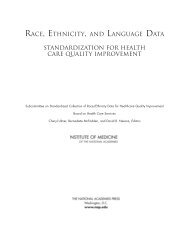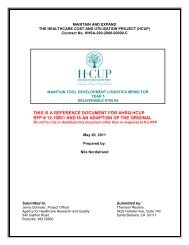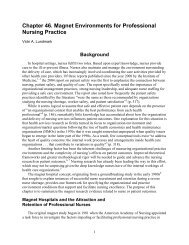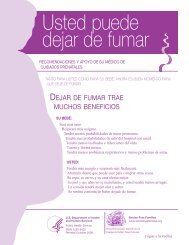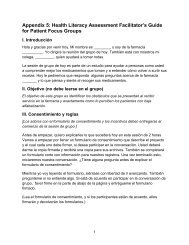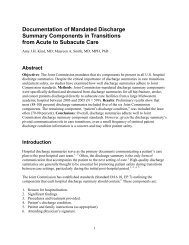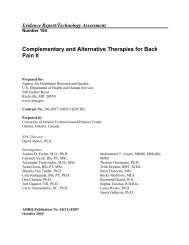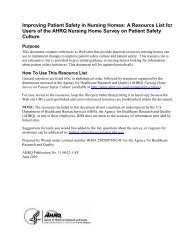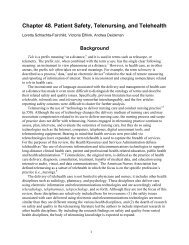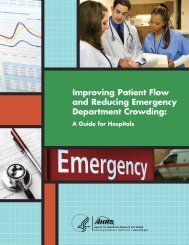Chapter 11. Reducing Functional Decline in Hospitalized Elderly
Chapter 11. Reducing Functional Decline in Hospitalized Elderly
Chapter 11. Reducing Functional Decline in Hospitalized Elderly
Create successful ePaper yourself
Turn your PDF publications into a flip-book with our unique Google optimized e-Paper software.
Patient Safety and Quality: An Evidence-Based Handbook for Nurses<br />
Age-Associated Changes<br />
A number of known physiological changes occur with ag<strong>in</strong>g, <strong>in</strong>clud<strong>in</strong>g reduced muscle<br />
strength and aerobic capacity, vasomotor <strong>in</strong>stability, baroreceptors <strong>in</strong>sensitivity and reduced total<br />
4, 11, 12<br />
body water, reduced bone density, reduced ventilation, and reduced sensory capacity.<br />
Comorbid conditions and chronic illness may heighten these changes. Muscle mass and muscle<br />
strength are reduced with ag<strong>in</strong>g and contribute to a reduction of physical activity. 12 With ag<strong>in</strong>g,<br />
alterations <strong>in</strong> autonomic function, <strong>in</strong>clud<strong>in</strong>g baroreceptor <strong>in</strong>sensitivity, occurs. Age-associated<br />
reduction <strong>in</strong> body water and plasma volume may predispose the elderly to syncope. Respiratory<br />
mechanics are also altered with ag<strong>in</strong>g, with reduced ventilation, <strong>in</strong>creased residual capacity, and<br />
reduced arterial oxygen tension. 12 Other age-associated changes <strong>in</strong>clude reduced bladder<br />
capacity and <strong>in</strong>creased ur<strong>in</strong>e production, prostrate enlargement, bone dem<strong>in</strong>eralization, loss of<br />
12, 13<br />
taste and smell, decreased sk<strong>in</strong> <strong>in</strong>tegrity, and reduction <strong>in</strong> sensory <strong>in</strong>put.<br />
As a result, the elderly are at higher risk for adverse physiological consequences dur<strong>in</strong>g acute<br />
illness, <strong>in</strong>clud<strong>in</strong>g impairment <strong>in</strong> functional status. Frailty—a state of musculoskeletal weakness<br />
and other secondary, widely distributed losses <strong>in</strong> structure and function—has been found to be<br />
attributed to decreased levels of activity and has been l<strong>in</strong>ked to the process of ag<strong>in</strong>g. 14 Advanced<br />
age, acute and chronic disease and illness, functional limitations, and decondition<strong>in</strong>g all<br />
contribute to the older adult’s vulnerability to functional decl<strong>in</strong>e dur<strong>in</strong>g hospitalization.<br />
<strong>Functional</strong> decl<strong>in</strong>e—the <strong>in</strong>ability to perform usual activities of daily liv<strong>in</strong>g due to weakness,<br />
reduced muscle strength, and reduced exercise capacity—occurs due to decondition<strong>in</strong>g and acute<br />
illness dur<strong>in</strong>g hospitalization. 15<br />
<strong>Functional</strong> Status<br />
<strong>Functional</strong> status is determ<strong>in</strong>ed by the ability to perform activities of daily liv<strong>in</strong>g (ADLs)—<br />
eat<strong>in</strong>g, dress<strong>in</strong>g, bath<strong>in</strong>g, ambulat<strong>in</strong>g, and toilet<strong>in</strong>g—and <strong>in</strong>strumental ADLs (IADLs)—<br />
shopp<strong>in</strong>g for groceries, meal preparation, housework, laundry, gett<strong>in</strong>g to places beyond walk<strong>in</strong>g<br />
distance, manag<strong>in</strong>g medications, manag<strong>in</strong>g f<strong>in</strong>ances, and us<strong>in</strong>g a telephone. 4 It is estimated that<br />
up to 8 percent of community-dwell<strong>in</strong>g elders need assistance with one or more ADLs. Among<br />
those age 85 and older, the percentage who live at home but need assistance or who live <strong>in</strong> a<br />
nurs<strong>in</strong>g home <strong>in</strong>creases significantly to 56 percent of women and 38 percent of men. 4 Chronic<br />
illness and comorbidities can directly impact functional status <strong>in</strong> the elderly. Chronic health care<br />
conditions that are most prevalent <strong>in</strong> the elderly <strong>in</strong>clude heart disease, hypertension, arthritis,<br />
diabetes, and cancer. 3 Acute illness due to chronic disease and chronic comorbidities accounts<br />
for a significant number of hospitalizations <strong>in</strong> the elderly.<br />
<strong>Functional</strong> <strong>Decl<strong>in</strong>e</strong> Dur<strong>in</strong>g Hospitalization<br />
Dur<strong>in</strong>g hospitalization, the elderly patient often experiences reduced mobility and activity<br />
levels. <strong>Functional</strong> decl<strong>in</strong>e, <strong>in</strong>clud<strong>in</strong>g changes <strong>in</strong> physical status and mobility, has been identified<br />
as the lead<strong>in</strong>g complication of hospitalization for the elderly. 16 The hazards of bed rest dur<strong>in</strong>g<br />
hospitalization are well established and <strong>in</strong>clude immobility, accelerated bone loss, dehydration,<br />
malnutrition, delirium, sensory deprivation, isolation, sheer<strong>in</strong>g forces on the sk<strong>in</strong>, and<br />
<strong>in</strong>cont<strong>in</strong>ence (see Table 1).<br />
12, 17<br />
Bed rest results <strong>in</strong> a reduction of exercise capacity due to several physiologic changes that<br />
occur, <strong>in</strong>clud<strong>in</strong>g reductions <strong>in</strong> maximal stroke volume, cardiac output, and oxygen uptake. 17 The<br />
2



